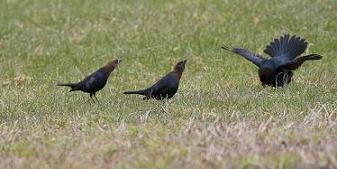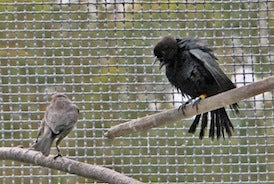
La página que intenta visitar sólo está disponible en inglés. ¡Disculpa!
The page you are about to visit is currently only available in English. Sorry!

 When singing, males brown-headed cowbirds will often raise their back and chest feathers, lift their wings and spread their tail feathers, and then bow forward. Displays like the one above are directed toward males because females prefer more conservative displays. (Photo: Matt MacGillivray/CC-by-2.0) |
From human pick-up lines to the peacock’s flashy feathers, males have a multitude of techniques for impressing the ladies. Though traditional sexual selection theory suggests females prefer the most passionate courtship display a guy can muster, shy brown-headed cowbirds may be in luck. A new study shows lady cowbirds prefer less intense male courtship displays, suggesting manly shows of physical prowess are just intended to intimidate rivals.
“Threatening the female during courtship, it makes sense you wouldn’t get a lot of success,” explains Adrian O'Loghlen, lead author of the study published May 2 in PLoS ONE.
Male brown-headed cowbirds, O’Loghlen says, will puff their feathers, spread their wings, and bow while singing to both potential mates and other males (see video below). The displays to males, however, are more dramatic than those directed at females. “To females, they tended not to bow, only puffed out their feathers and spread wings slightly,” O’Loghlen says.
 A brown-headed cowbird female, left, being courted by a male, right. A new study suggests females prefer less flashy and intense displays during courtship. (Photo courtesy Adrian O'Loghlen) |
O'Loghlen and his colleagues at the University of California Santa Barbara found the reason for this difference is that females are more sexually attracted to conservative visual displays. O’Loghlen and Stephen Rothstein presented eight female brown-headed cowbirds with audiovisual recordings of the same males’ displays to both females and other males. To test the females’ arousal, they looked at the females’ reactions.
“The female has a display herself,” O’Loghlen says. “When she’s sexually excited, the female responds with a copulation solicitation display, which is literally an invitation to copulate.”
All eight lady cowbirds were more sexually attracted to the less-intense displays originally directed toward females. “That’s counter to what you’d expect from sexual selection theory,” O’Loghlen says.
While they don’t know why this is the case, O’Loghlen thinks the intense displays appear more aggressive—not exactly a turn-on. But why would males bother displaying to female cowbirds at all, if they don’t seem to like it?
One possibility, O’Loghlen says, is that the best way for females to determine a males’ age is through display. Year-old males will still have a bit of light brown plumage from their youth underneath their wings, he says.
“One of the most obvious features of the display is the wingspread, and of course by doing that, they reveal whether they are yearlings or adults,” he explains. “Birds that have survived their first year are of a higher genetic quality than younger birds.”
Provided they secure funding, O’Loghlen and his colleagues would like to artificially color the light plumage—perhaps using Photoshop on audiovisual recordings of male displays—and record female responses.
Male brown-headed cowbirds exhibit a visual display, shown above, when singing. |
This study, and any future exploration into female cowbird preferences, wouldn’t be possible without modern technology.
“In the past people have tried to do audiovisual recordings of birds to see their reactions to full, acoustic and physical, display,” O’Loghlen says. “But, there were screen problems. We’ve found using more modern monitors we can get birds to respond to the visual information”
Related: